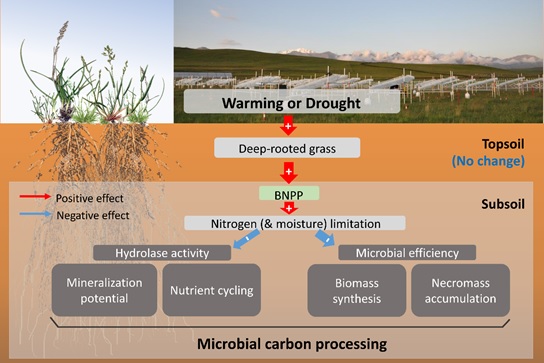
Subsoils deeper than 30 cm belowground contain > 50% of soil organic carbon (SOC) globally, but they remain under-investigated in terms of their response to climate change. Recent evidence suggests that warmer, drier conditions in alpine grasslands induce divergent responses in SOC decomposition and carbon accrual in the top- vs. subsoils. However, longer-term effects on microbial activity and belowground carbon cycling are not well understood.
Researchers from the Institute of Botany of the Chinese Academy of Sciences (IBCAS) and their collaborators published a mechanistic study on the warming and drought effects on microbial carbon processing in alpine grasslands on Feb. 2 in Global Change Biology.
"Soil microbes may regulate SOC dynamics via at least three pathways, they decompose SOC via secreting carbon-degrading extracellular enzymes and mineralizing organic substrates into greenhouse gases, mediate soil nutrient cycling by secreting nitrogen- and phosphorus-acquiring enzymes, which in turn affects plant growth and microbial activity, and contribute to SOC formation by converting degradable organic matter into microbial necromass and byproducts via iterative turnover of the living community, which tend to accrue in the relatively slow-cycling soil fraction and contribute to soil carbon sink potentials in the long term," said Prof. FENG Xiaojuan at IBCAS. "We aim to elucidate and compare these pathways driving changes in microbial carbon processing at different soil depths."
The world's highest and largest plateau, Qinghai-Tibetan Plateau, harbors a vast area of alpine grasslands that experience a warming trend of 0.2 °C per decade, accompanied by decreasing rainfall in most regions in recent years.
The researchers utilized a long-term field manipulation experiment on the Qinghai-Tibetan Plateau in combination of a laboratory soil incubation with 13C-labeled grass litter to assess microbes' role as both 'decomposers' and 'contributors' of SOC in the top- (0–10 cm) vs. subsoils (30-40 cm) after five years of warming and drought treatments.
Microbial mineralization of both SOC and added litter was examined in tandem with potential extracellular enzyme activities, while microbial biomass synthesis and necromass accumulation were analyzed using phospholipid fatty acids and amino sugars coupled with 13C analysis, respectively.
They found that warming and, to a lesser extent, drought intensified microbial nitrogen limitation at depth. Both SOC and litter mineralization reduced in the subsoil, which may be related to nitrogen limitation, as evidenced by lower hydrolase activity and reduced microbial efficiency (for both biomass synthesis and necromass accumulation relative to respiration). However, none of these effects were observed in the topsoil, suggesting that soil microbes became inactive and inefficient in subsoil but not topsoil environments.
Given increasing belowground productivity in this alpine grassland under warming, both elevated root deposits and diminished microbial activity may contribute to new carbon accrual in the subsoil. However, the sustainability of plant growth and persistence of such a subsoil carbon sink deserve further investigation on a longer term, given the aggravated nitrogen limitation at depth. These results shed new light on microbial pathways driving subsoil carbon stability under climate change.

Mechanisms regulating the warming and drought effects on microbial carbon processing (Image by ZHU et al.,)

86-10-68597521 (day)
86-10-68597289 (night)

52 Sanlihe Rd., Xicheng District,
Beijing, China (100864)

